"Stir-Fry Sensations" February 18, 2010 - Volume 2 - Issue 04
|
|
|
|
|
|
West, Meet East
|
Fast,
delicious and healthy! What's wrong with this picture? Not much! We're
a huge fan of stir-fried meals where the delicious flavors of
vegetables and meats are sauced in the magical flavors of Chinese
cuisine. No longer do you need to satisfy that craving for Chinese food
by going out or picking up the phone, you can easily have it at home.
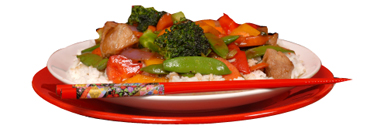
This
issue provides some of the secrets for making a great stir-fry with
hints for how to cook quickly on high heat. We set you up with some of
our best tool picks for increasing your stir-fry prowess. Finally, we
demystify some of the secret ingredients that are the key to great
Chinese stir-fry dishes. To get you started on your journey to the
East, we feature three recipes from Helen Chen, the daughter of the
famed Joyce Chen, that are perfectly designed for the Western cook
wanting to create some great Chinese stir-fries. Mouth watering yet? It
will be!
|
|
|
|
Knife Skills Class - March 25th
|

|
Stir-Fry Techniques
|
With
the imminent arrival of spring, this is a great time to adopt and
develop some stir-fry cooking skills. Make it your "thing" to master
this season! Stir-fries hold the possibility of endless variety;
they're easy to make several times a week while producing very
different meals each time. Here are some tricks to cooking hot and fast:
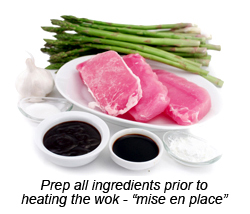
Prep Everything First
- Cooking over high heat makes things happen quickly. Peel, chop, cut,
measure EVERYTHING in the recipe first. This is essential for good
stir-fry results and allows all of the ingredients to be at their prime
in the finished dish.
Size Ingredients Evenly
- When prepping the ingredients, dice, cut, chop, or julienne each
ingredient into bite-sized pieces of relatively even sizes. Choose to
prepare your ingredients in thin slices or matchsticks so that the heat
from the surface can quickly get to the center of the food.
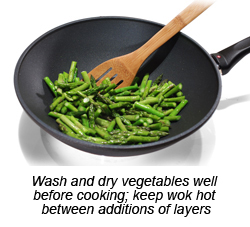 Plan the Sequence of Events
- With all of the ingredients prepped, literally line everything up in
the order that it will go into your wok or pan. Some vegetables will
take longer to cook than others. For example, beans, peppers, broccoli,
asparagus will take longer than sprouts, zucchini, cabbage, or bok choy. Plan the Sequence of Events
- With all of the ingredients prepped, literally line everything up in
the order that it will go into your wok or pan. Some vegetables will
take longer to cook than others. For example, beans, peppers, broccoli,
asparagus will take longer than sprouts, zucchini, cabbage, or bok choy.
Start Hot, Keep it Hot
- Before adding any food to the pan, allow the pan to become hot, add
any oil to the pan and allow it to become very hot - about 30 seconds.
To test if the pan is ready, flick a minute drop of water in the oil;
it should sizzle vigorously. When adding the different layers of
ingredients during cooking, allow the pan to return to full heat before
adding more ingredients. Start it hot, and always keep it hot!
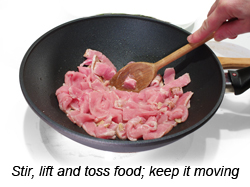 Keep it Moving
- Because the pan is very hot, it is essential to keep the food moving
while cooking. This is what's behind the technique's name "stir-fry."
The surface of the food becomes hot quickly and transfers the heat
inward. Keep it Moving
- Because the pan is very hot, it is essential to keep the food moving
while cooking. This is what's behind the technique's name "stir-fry."
The surface of the food becomes hot quickly and transfers the heat
inward.
Center the Action
- Beginning with the ingredients that take the longest to cook, keep
the primary cooking action in the center of the pan - that's where it's
the hottest. Move the cooked ingredients up the sides and add the next
layer to the center of the wok stirring vigorously in that sweet spot.
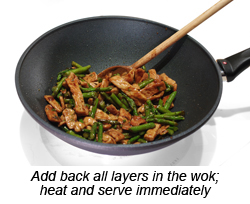 Don't Overload the Pan
- A good stir-fry result depends on the food contacting the cooking
surface. Avoid the temptation to pile in ingredients - you will have a
"steam-fry" instead of a stir-fry! If needed, remove a layer of
ingredients to a plate while cooking the next set of ingredients. Keep
in mind that the offloaded ingredients will continue to cook, so remove
just prior to doneness, and spread in a single layer to release any
excess heat. At the end of cooking, add all layers back into the pan to
combine and reheat. Don't Overload the Pan
- A good stir-fry result depends on the food contacting the cooking
surface. Avoid the temptation to pile in ingredients - you will have a
"steam-fry" instead of a stir-fry! If needed, remove a layer of
ingredients to a plate while cooking the next set of ingredients. Keep
in mind that the offloaded ingredients will continue to cook, so remove
just prior to doneness, and spread in a single layer to release any
excess heat. At the end of cooking, add all layers back into the pan to
combine and reheat.
Adjust the Recipe
- Many recipes prescribe cooking times for each stage of the stir-fry.
Use this information as a starting point and adjust based on how the
food is cooking. This variability arises from the differences in food
temperature, quantity of food, your pan, and the type of heat source.
Remove Quickly
- Once the stir-fry is complete, remove from the pan, and serve
immediately. Hot food left to sit will continue to cook and challenge
the desired crisp-tenderness of the vegetables. In fact, stir-fry
tradition calls for everyone being seated at the table before the
cooking begins!
|
Wok & Roll!
|
Great
stir-fry results are accessible to anyone with minimal investment! In
fact, you can make a great stir-fry in any skillet or pan, but a great
wok certainly eases the process and enhances the outcome.
The WokThe
idea behind a wok is its deep, rounded shape that provides a lot of
cooking surface without requiring a large burner or flame. Heat
transfers quickly from the concentrated source at the wok's bottom and
up its steep sides. It's the original energy efficient pan! Besides
stir-frying a wok is versatile for braising, simmering, steaming, and
deep-frying. It's truly the "all-in-one" pan that millions of families
have counted on for many centuries.
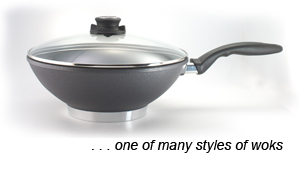 Choosing a Wok Choosing a Wok
When choosing a wok, there are a few characteristics to consider. The
first consideration is what heat source will be used with the wok - gas
or electric burners, ceramic top, or induction stovetop. Different woks
are specifically made and matched to different heat sources. Shape -
Woks have rounded bottoms and either set atop a ring for stability over
the burner, or on a specialized burner grate. Obtain a wok ring that
best matches your burner's configuration. Other woks have a flatter
bottom that sit like a more traditional pan on top of a burner, yet
still feature high, concave sides. Size
- Choose a size of wok that meets your most common cooking
requirements. A 12-14-inch wok is usually perfect for home cooking and
meals for 2-4 people. Material -Carbon Steel and Cast Iron
- Traditionally, woks have been made of carbon steel or cast iron. This
type of surface requires seasoning and re-seasoning to prevent rust and
to foster a naturally non-stick environment. Many woks in the West go
unused because of the diligence involved in seasoning the pan and
keeping it in top-notch condition. In Asian cultures, wok maintenance is
not an issue - the wok is used frequently enough that the pan becomes
seasoned and stays seasoned with no effort. Material - Nonstick Surfaces
- For many of us, a nonstick wok offers just the right amount of
practicality and purpose. However, choose a non-stick wok wisely; some
nonstick surfaces are not suitable for high temperature cooking. Newer,
safer, nonstick surfaces are now available and have been applied in
some great new wok styles. 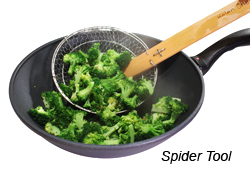 With nonstick surfaces, very little oil is required allowing the stir-fry dish to be a healthy preparation. Handle Style
- When cooking with high temperatures, handle considerations become an
important feature. A long handle with an opposing helper handle works
well. Stirring SpatulasTo
keep things moving while stir-frying, a good stirring utensil is
essential! A good utensil for stir-frying has a long-handle to keep the
hand a safe distance from the high temperatures. Traditionally, bamboo
or wooden spatulas have been used in wok cookery and still prove a good
choice. Many of the newer silicone spatulas also work well at high
heat, and have a bit of flexibility allowing them to conform to the
curved shape of the pan.
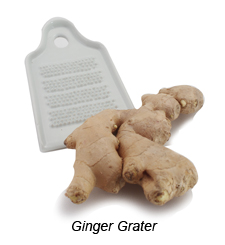 Spiders Spiders
A "spider" is a very good wok tool! The broad basket of this
long-handled utensil features an open weave resembling a spider's web.
Food scooped with a spider drains very quickly. Beyond pairing it with
a wok, a spider is versatile in scooping any food from boiling water,
or a handy strainer when draining a pot.
Ginger Grater
Among the aromatics in stir-fry dishes, ginger is a frequent
contributor. Working with ginger and its odd shape and coarse, stringy
pulp often poses a conundrum. A ginger grater solves the problem by
ingeniously extracting the potent pulp and liquid leaving behind the
peel and fibers. There are several styles of ginger graters but all
work similarly through a rubbing motion on top of a bumpy surface.
|
Flavor Secrets for Chinese Stir-Fries
|
The
craving for Chinese food can be strong! What's behind these urges? We
think it's a unique combination of flavors and a few secret sauces that
characterize American Chinese dishes as irresistible. With just a bit of
explanation and experimentation, you can become comfortable with some
of the basic flavor secrets in Chinese stir-fries.
 Soy sauce
- Like many other foods, special yeast and microorganism fermentation
processes turn grain or soybeans into a rich brown liquid that is salty
and full of the "fifth taste," umami. There are many variations of soy
sauce specific to different regions of the world. Soy sauce
- Like many other foods, special yeast and microorganism fermentation
processes turn grain or soybeans into a rich brown liquid that is salty
and full of the "fifth taste," umami. There are many variations of soy
sauce specific to different regions of the world.
Hoisin Sauce
- While "hoisin" means seafood, there is no fish present. This sauce
includes water, sugar, soybeans, vinegar, rice, salt, wheat flour,
garlic, and chile peppers. The sauce may be used for glazing, dipping,
or as a sauce component.
Oyster Sauce
- This sauce is made from broth leftover from cooking oysters. The
broth is greatly reduced from its original state until it becomes a
dark, viscous sauce. It does not have a fishy smell or flavor, but is
full of rich flavors that complement many stir-fries.
Black Bean Sauce
- This sauce is also an essential condiment in many Chinese stir-fries.
It is made from fermented black beans that are salty, bitter, and sweet
all at once. Garlic and soy sauce are added to form a thick sauce or
paste. A little goes a long way with this magical ingredient.
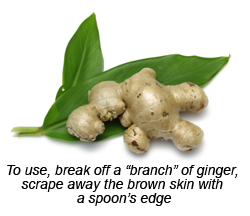 Ginger
- This aromatic provides essential flavor to many stir-fry dishes. Peel
away the thin brown skin on the nubby surface by scraping it away with
a spoon. Buy small, usable quantities. Leftover ginger may be stored in
an odor-proof bag or container in the refrigerator or freezer. Ginger
- This aromatic provides essential flavor to many stir-fry dishes. Peel
away the thin brown skin on the nubby surface by scraping it away with
a spoon. Buy small, usable quantities. Leftover ginger may be stored in
an odor-proof bag or container in the refrigerator or freezer.
Rice Wine
- Most stir-fries in Ms. Chen's cookbook use just a teaspoon or two of
rice wine. This mildly flavored wine serves to dissolve the essential
flavor oils found in the other ingredients. Such oils are only
dissolvable with a bit of alcohol - oil and water won't unleash their
flavors. The alcohol will evaporate away, but only after working its
extra bit of magic.
|
Smart Stir-Fry Tips
|
Tip #1:
When serving rice with your stir-fry, start it first before starting
your prep work. In a microwave, the rice will cook quickly and hold
well as you assemble your stir-fry.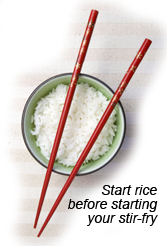
Tip #2:
Check out Asian specialty markets for unique ingredients. You'll find a
wide selection of many key ingredients and usually at a lower price
than the supermarket's specialty food aisle.
Tip #3:
Use oil that can tolerate high heat well when stir-frying. Oils with
high smoke points (the point at which they begin to burn) include these
refined oils: canola oil, safflower oil, peanut oil, soybean oil, and
corn oil. Oils with lower smoke points should be avoided in
stir-frying; they include olive oil, butter, sesame oil, and many
animal fats.
Tip #4: If
liquid is gathering in the bottom of the pan while stir-frying, this is
an indication that the pan is not hot enough or that it is overloaded.
The wok or pan should be so hot that any water in the ingredients
evaporates quickly while cooking.
Tip #5:
When starting a stir-fry, once the pan is hot, drizzle any oil being
used around the pan. This will heat the oil faster compared to pouring
the oil into one location all at once.
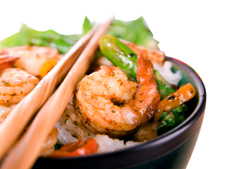
Tip #6:
After washing or cleaning any vegetables, pat them or "spin-dry" them
to remove any excess water. This will help reduce any water
accumulation during stir-frying.
Tip #7:
To easily slice meats into thin, thin sheets for stir-frying, freeze
the meat for 30-45 minutes, or allow frozen meat to partially defrost.
Slice the meat across the grain to create naturally tender pieces.
|
Q & A's
|
 Q: What is the difference between light and dark soy sauce? Q: What is the difference between light and dark soy sauce?
A: Light soy sauce comes from the "first pressing" of the fermented beans. 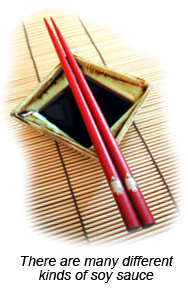 Dark
soy sauce is darker, thicker, and aged longer. Light soy sauce is
saltier than dark and is used more as a condiment or table seasoning.
Dark soy is sweeter due to added molasses and used more in cooking than
at the table. Dark
soy sauce is darker, thicker, and aged longer. Light soy sauce is
saltier than dark and is used more as a condiment or table seasoning.
Dark soy is sweeter due to added molasses and used more in cooking than
at the table.
Q: In the ingredients list on my soy sauce, I see acid-hydrolyzed vegetable protein. What is this?
A:
This is a protein form that has been broken down into components
through the introduction of water and acid. This ingredient is often
used in soy sauces that skip the fermentation step and have garnered
the nickname of "cheap man's soy sauce." The dark color in these sauces
is not natural, but added caramel coloring. Read the label before
buying.
Q: How do I season a carbon steel wok?
A:
Seasoning is easy and an important step for setting up a new wok, or
refurbishing an older steel wok. Clean a new wok well to remove any
waxy, protective coating from the manufacturer. This will expose the
bare metal. Rub heat-tolerant oil into the surfaces of the metal.
Facilitate the bonding of the oil to the pan by heating it and rubbing
on the inside surface. Allow the pan to cool, then rub away any excess
oil. Repeat this process three or four times. Keep the wok in a
seasoned state by avoiding detergents and soap when cleaning. Simply
wipe the wok clean, rinse with plain water if necessary, and dry
immediately and thoroughly.
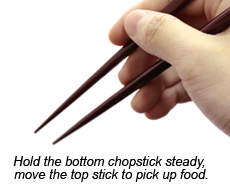
Q: What is proper chopstick etiquette?
A:
Stir-fries are a great opportunity to practice your chopstick skills!
To learn how to eat with chopsticks, check out this link: "How to Use Chopsticks."
Use the wider ends of the chopstick to serve food from a shared bowl to
your own plate or bowl. Never place the chopsticks straight up in your
bowl of food; this is considered bad luck. Never point or gesture with
your chopsticks. It's ok to hold a bowl in your hand and bring it
closer to your mouth when eating with chopsticks; this minimizes
spilling and is considered the polite thing to do in many instances. |
|
Cookbook Review
|
Easy Chinese Stir-Fries by Helen Chen. Photography by Jason Wyche. Copyright 2009. Published by John Wiley & Sons, Inc., Hoboken NJ.
This
little cookbook is a gem! With its singular focus on Chinese
Stir-Fries, it allows the Western kitchen access to the wonderful
flavors of American-Chinese cuisine. Ms. Chen comes by her expertise
honestly. As the daughter of the famed Chinese cook and restaurateur,
Joyce Chen, Ms. Chen carries forward the long-standing family tradition
of popularizing Mandarin cuisine in the 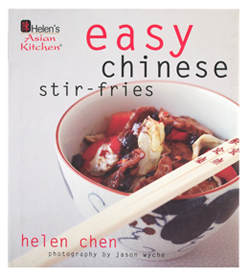 American
culture. The beginning chapters of the book focus on setting the stage
with succinct and informative discussions of stir-fry technique,
equipment, and key ingredients. The recipe chapters that follow
categorize a whole host of stir-fry inventions according to: Chicken,
Pork, Beef, Seafood, Bean Curd, and Vegetables. Each recipe is written
simply and expertly. The simplified ingredients make each of the
recipes accessible for the average cook without compromising delicious
results. The step-by-step instructions are equally clear and
explanatory. The typical American cook suddenly feels quite apt and
able to tackle their favorite Chinese dish at home! As is often the
case with us, we were especially taken by the beautiful, close-up
photography that accompanies nearly every recipe. We enjoyed
experimenting with many different Chinese stir-fries with this book as
our tutor, and think you will too! American
culture. The beginning chapters of the book focus on setting the stage
with succinct and informative discussions of stir-fry technique,
equipment, and key ingredients. The recipe chapters that follow
categorize a whole host of stir-fry inventions according to: Chicken,
Pork, Beef, Seafood, Bean Curd, and Vegetables. Each recipe is written
simply and expertly. The simplified ingredients make each of the
recipes accessible for the average cook without compromising delicious
results. The step-by-step instructions are equally clear and
explanatory. The typical American cook suddenly feels quite apt and
able to tackle their favorite Chinese dish at home! As is often the
case with us, we were especially taken by the beautiful, close-up
photography that accompanies nearly every recipe. We enjoyed
experimenting with many different Chinese stir-fries with this book as
our tutor, and think you will too!
|
|
Recipes for Easy Chinese Stir-Fries
|
Recipes excerpted from Easy Chinese Stir-Fries
by Helen Chen. Copyright 2009. Published by John Wiley & Sons,
Inc., Hoboken NJ. Reprinted with permission of the publisher. All
rights reserved.
Stir-fried Pork with Asparagus
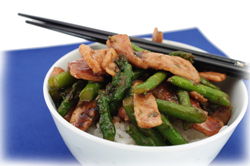 With
asparagus season just around the corner, put this stir-fry on your
"must-try" list. The hoisin sauce added just a hint of sweetness that
complemented the pork perfectly. The seared asparagus concentrated the
vegetable's flavor and the pork browned quickly over the high heat. The
light covering of sauce exceeded our expectations in taste and flavor. With
asparagus season just around the corner, put this stir-fry on your
"must-try" list. The hoisin sauce added just a hint of sweetness that
complemented the pork perfectly. The seared asparagus concentrated the
vegetable's flavor and the pork browned quickly over the high heat. The
light covering of sauce exceeded our expectations in taste and flavor.
Click here to view the full, illustrated recipe.
Click here for a printable version of the recipe. (PDF format)
Stir-fried Broccoli Beef in Oyster Sauce
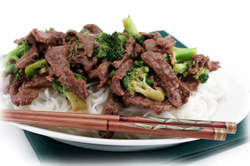 Another
favorite for just about everyone, this easy beef and broccoli dish will
become a regular at your table! We served this stir-fry over rice
noodles, which made for a little extra fun. The sauce is based on
prepared oyster sauce, but lends no fishy component whatsoever. We
purchased double the beef, sliced it all, and froze half in a thin
package for a quick supper sometime in the near future! Another
favorite for just about everyone, this easy beef and broccoli dish will
become a regular at your table! We served this stir-fry over rice
noodles, which made for a little extra fun. The sauce is based on
prepared oyster sauce, but lends no fishy component whatsoever. We
purchased double the beef, sliced it all, and froze half in a thin
package for a quick supper sometime in the near future!
Click here to view the full, illustrated recipe.
Click here for a printable version of the recipe. (PDF format)
Kung Pao Chicken
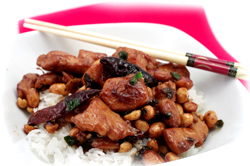 This
perennial take-out favorite is now within easy reach at home with this
recipe! This stir-fry has a few more ingredients compared to the other
stir-fries, but the result is worth the effort! We served this chicken
dish over a mound of rice and thoroughly enjoyed each chopstick-full.
The recipe provides a solid base that begs for further experimentation
and personalization. This
perennial take-out favorite is now within easy reach at home with this
recipe! This stir-fry has a few more ingredients compared to the other
stir-fries, but the result is worth the effort! We served this chicken
dish over a mound of rice and thoroughly enjoyed each chopstick-full.
The recipe provides a solid base that begs for further experimentation
and personalization.
Click here to view the full, illustrated recipe.
Click here for a printable version of the recipe. (PDF format)
|
 |
|
Lorraine, Katie, and all of the Staff at Beyond Pots and Pans
|
|
|
|
|